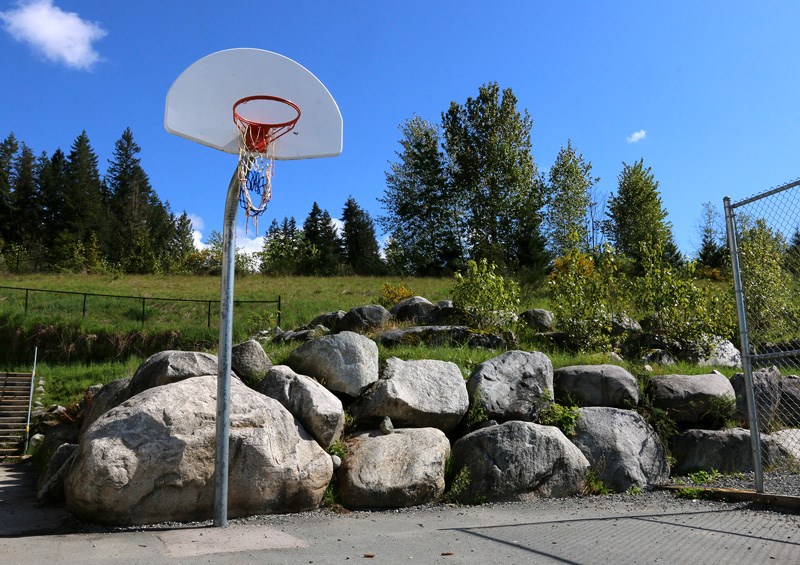Students and parents at Eagle Mountain Middle School feel caught in the middle of an apparent standoff between School District 43 and the owners of a faulty septic field that’s contaminated groundwater near the school with E. coli and fecal coliform.
Dianne MacSporran, chair of Eagle Mountain’s parent advisory council, said while the removal of fencing that had closed off a basketball court, as well as a hillside that was used as a play area and shortcut by students, for more than two years to keep them away from contamination, “looks deceptively like a good news story, It’s very concerning to parents.”
Robert Boies, a representative of the strata for Anmore Green Estates, a 51-home development that is serviced by the septic field, said the fencing was removed last week because homeowners in the complex “can no longer carry the weight” of monthly rental fees being charged by the school district to allow the barrier on its property. Those fees have amounted to $35,000, as well as an initial $11,000 licensing fee to access the property.
Boies said it’s the school district’s greed that’s standing in the way of resolving the situation.
——————————————
Want to know more about this story?
Is there finally a sewage solution for Anmore Green?
Parents say words aren't stopping flow of sewage onto school grounds
Septic problem becomes a war of words
Engineers say Anmore Green's septic problems can't be fixed
Septic issue bubbles to surface near school
——————————————
Boies said discussions stalled with SD43 to allow construction underneath its property of the pipe that will connect AGE to the regional sewer network just 67 metres away in Port Moody.
On March 17, the school district proposed a further payment of $372,000 to pay for the easement underneath its property, along with another $24,000 as compensation for project management, administrative and legal costs.
That’s on top of the approximately $1 million cost to AGE’s homeowners to have the complex hooked up to the sewer system.
Chris Nicolls, SD43’s secretary treasurer and chief financial officer, said its demand is based on about 792 sq. metres of its property being encumbered by the pipe at a market value of $470.92 per sq. m. He added the strata “does have a sewer connection alternative that does not involve crossing or encumbering school district property.”
But such alternatives were described by a 2018 engineering report commissioned by AGE as being impractical or too expensive, a finding supported by a peer review ordered by the Ministry of Environment and Climate Change Strategy.
Boies, a realtor, told The Tri-City News the maximum value for an underground easement on property that can’t be developed should come in at about $21,000.
“They’re clearly trying to make money off this,” he said of the school district’s demands.
Subsequent negotiations, including a counter proposal by the strata to sell the entire 6,053 sq. m. septic field to the school district at the same market value price, have gone nowhere.
Nicolls said the school district is “disappointed that our discussions with AGE have been put on hold.” But, he added, it remains receptive to “further dialogue.”
Boies said the school district’s position is especially egregious since it’s known since 2001 the septic field could present a problem to its plan to construct Heritage Woods Secondary School and the subsequent middle school that was opened in 2015.
The problem was acknowledged in the sales agreement for the property between SD43 and the city of Port Moody, which contained a clause that both parties “shall act reasonably and cooperate with each other to minimize and control any such problems.”
Environmental assessments and engineering reports obtained by The Tri-City News that were prepared in advance of construction of the schools, as well as adjacent sports fields, also warned of “septic discharge migration.”
The problem finally burbled to the surface in September 2017, when routine testing discovered elevated levels of E. coli and fecal coliform at three locations near the school. Two months later, the ministry issued a pollution abatement order to AGE and on Dec. 22 of that year, the strata erected the fencing to mitigate the public health risk of possible exposure to the contaminated water.
Since then, AGE and several jurisdictions of government have been in protracted negotiations to resolve the issue by connecting the homes directly to the regional sewer network.
Boies said those discussions accelerated when a facilitator was appointed by the province late last year. They included an agreement by Anmore last February to create a local service area agreement with the Greater Vancouver Sewerage and Discharge District that manages the regional sewer system to facilitate a connection to AGE.
Boies said the strata hopes that by removing the fencing, it will send “a message to those in power that have the authority to order a connection to happen.” He added it will be up to the ministry to decide if the fencing’s removal contravenes the pollution abatement order that remains in effect, and then determine next steps.
Nicolls said that if the fencing is gone, then the ministry must have deemed the area safe.
“Therefore, we no longer have any issues to be resolved with AGE.”
But MacSporran said she isn’t comforted.
“The PAC are worried about the risk to our students in the future and our community currently,” she said.



